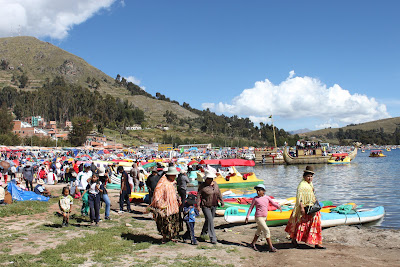
Visiting the Cerro Rico co-operative mines is a shocking and sad experience.
It´s very, very dark - apart from the light of your headlamp it´s difficult to see much and the smell can be overpowering - sulphur, silica dusk and other noxious chemicals (the presence of asbestos is unconfirmed). In places, I found myself literally squeezed between two solid rocks, gasping for breath in the acrid conditions.
However, the most challenging part of the tour was psychological. The further in you go the more terrifying it becomes and the breathing becomes heavier and heavier.
We walked 250 metres into the Cerro Rico, ducking the various bits of wood and rock, and dodging the thundering metal carts that flew passed (despite being 300 years old, the mine is still in use). The deeper and deeper you go, the more your mind tells you to turn back and the more you start thinking of things you shouldn´t - the Copiapo mining incident last year, for example, as well as the lives and deaths of hundreds and thousands of miners over the years. They are not far from your mind especially when I was lying flat on my front, squeezed between the floor and the ceiling in the darkness.
On the way there, we were taken to a miner´s market, where we could buy presents for the miners - practical things like food and drink as well as dynamite. However, it´s the presence of the 96% alcoholic sugar cane drink which, strangely enough, is the most sobering. It seems to be a work hard / play hard attitude, presumably to try and forget your daily experiences down the mine (we were told that one miner dies from an accident once every two weeks, on average).
The hardships faced by the miners might also explain the fierce sense of humour: they give each other pretty bad nicknames; Juan - our guide - also thought it funny to throw a stick of
lit dynamite at my feet. I suppose the sense of humour, along with the alcohol, has to be pretty robust, considering their working conditions.
Having been inside a mine for not more than two hours, inhaled the fumes, clambered and squeezed down small holes, felt the heat (and the altitude - we were well over 4,000 metres high), and serious considered my own mortality, it is still only a glimpse into the life of these miners - some who start working there as young as twelve and will unlikely live to see their fortieth birthday.
It was a Saturday and there was a miner football match going on. Even so, there were still teenagers / young men down there working in conditions that make it difficult for me to complain about working in an office again.
It´s pretty easy to describe my experience. But it is difficult to imagine being in such a situation as to have to go down a mine and work there for the rest of your life.
 Loving Cusco.
Loving Cusco.





 We took a boat to the north part and then walked 8 km south along a well trodden mountain path south passing by Inca ruins of houses, altars and temples. It was hard work, particularly considering the steep slopes and the altitude but definitely worth it. We followed a lady and son herding two alpacas along the way, passing through several checkpoints manned by elderly Bolivian men (with little / no change) who charge you a small fee for using the path.
We took a boat to the north part and then walked 8 km south along a well trodden mountain path south passing by Inca ruins of houses, altars and temples. It was hard work, particularly considering the steep slopes and the altitude but definitely worth it. We followed a lady and son herding two alpacas along the way, passing through several checkpoints manned by elderly Bolivian men (with little / no change) who charge you a small fee for using the path. PS - A general rule about South America: Just when you think a walk / road is finishing, you've likely got another 2 hours to go (the number of times we have thought - "just over this next hill and then we're there" only to find we are nowhere near our destination, has been countless)
PS - A general rule about South America: Just when you think a walk / road is finishing, you've likely got another 2 hours to go (the number of times we have thought - "just over this next hill and then we're there" only to find we are nowhere near our destination, has been countless)





